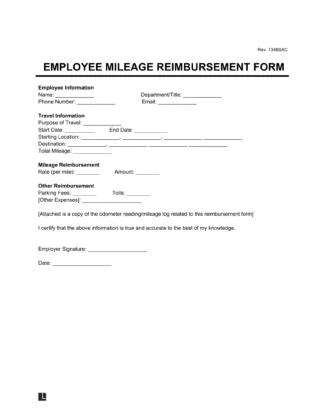
Report expenses paid on behalf of a company to receive reimbursement.

Published July 6, 2023
Written by Josh Sainsbury | Reviewed by Brooke Davis
An employee reimbursement form is a valuable tool for tracking work-related expenses. Employees can use the form to keep track of their costs on a weekly, monthly, or annual basis. Employers benefit from having a standard format that lists expense details.
Depending on the type of business, an employee may seek reimbursement for various expenses, including meals, mileage, travel, and supplies. Successful expense reimbursement requires the employer and employee to understand their roles.
Company documents such as an employment contract, consulting agreement, or work-from-home policy may outline your expense reimbursement policy. Reimburse your workers for employment-related expenses by taking the following steps:
Keep copies of the completed reimbursement form and documentation for your company’s records in case a labor dispute arises.
While your employer may have a contractual obligation to reimburse certain expenses related to your job, you, as the employee, must still provide proof of those expenses. Follow these steps to avoid confusion and receive the correct reimbursement:
Depending on your company’s processes, you may need to submit the approved employee reimbursement form to your payroll department. In some cases, your supervisor will do this for you.
An employee reimbursement form should include the following:
These details may differ depending on your company policy and procedures, so review your reimbursement policy with your supervisor or finance department before you submit your expenses. Incorrect submissions may prevent you from receiving reimbursement or lead to disciplinary action.
Avoid unnecessary delays and complications by filling out your employee reimbursement form as follows:
Your company may handle reimbursement forms from multiple employees. Keep your reimbursement on track by providing your printed name, job title, department, work email, and phone number. You should also clearly print your supervisor’s name with your information for easy reference.
List the details of your reimbursable expenses. Include whether they are for accommodations, travel, meals, supplies, or other reimbursable costs. Provide a clear description and explanation of the reason for each expense. Indicate the amount for each reimbursement request and the date you incurred the expense.
Receipts, bills, invoices, and credit card bills provide evidence of the amount and date of your expenditure. If you do not provide documented proof, your company may delay or deny payment.
Sign and date the declaration to indicate that the information you provided in your form is true and accurate to the best of your knowledge. This demonstrates that you incurred the listed expenses while performing your job duties. The declaration is also your acknowledgment that false or misleading expense reimbursement requests could result in disciplinary action.
Once you complete, sign, and date your employee reimbursement form, submit it to your supervisor for approval. They will review your form before signing, dating, and forwarding it to your finance or payroll department.
The finance department will review your expense documentation for accuracy. After this final check, the finance department will submit your employee expense reimbursement for payment. You may receive payment separately or in your regular paycheck.
You can simplify employee expenses by using this employee reimbursement form sample: